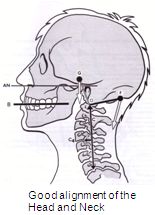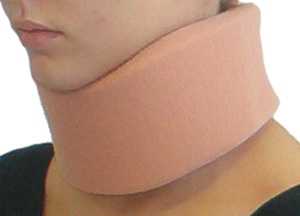Cervical Collar: Difference between revisions
No edit summary |
No edit summary |
||
| Line 9: | Line 9: | ||
== Definition/Description == | == Definition/Description == | ||
[[Image:Good-alignment-of-neck.png|left]]Neck collars are commonly used by patients who had a surgical intervention of the cervical spine to immobilize the neck. It is also used for the treatment against neck pain, which can be caused by an acute trauma or chronic neck pain. For example after a [http://www.physio-pedia.com/index.php5?title=Whiplash_Associated_Disorders whiplash injury], the neck collar will be used for both immobilization and to reduce pain. Although the value of the collar over early active mobilizations is being questioned, early mobilizations should give a greater improvement in cervical range of motion and in the reduce of pain after a whiplash injury.<ref>Mealy K. et al. Early mobilizations of acute whiplash injury. British Medical Journal. 1986; volume 292: 656-666.</ref> The main goal of neck collars is to prevent or minimize motion in the cervical spine. It also keeps the head in a comfortable gravity-aligned position, this means a normal cervical lordosis. The head is held high on the shoulders and the ears are directly over each shoulder (see figure). | [[Image:Good-alignment-of-neck.png|left]]Neck collars are commonly used by patients who had a surgical intervention of the cervical spine to immobilize the neck. It is also used for the treatment against neck pain, which can be caused by an acute trauma or chronic neck pain. For example after a [http://www.physio-pedia.com/index.php5?title=Whiplash_Associated_Disorders whiplash injury], the neck collar will be used for both immobilization and to reduce pain. Although the value of the collar over early active mobilizations is being questioned, early mobilizations should give a greater improvement in cervical range of motion and in the reduce of pain after a whiplash injury.<ref name="Mealy">Mealy K. et al. Early mobilizations of acute whiplash injury. British Medical Journal. 1986; volume 292: 656-666.</ref> The main goal of neck collars is to prevent or minimize motion in the cervical spine. It also keeps the head in a comfortable gravity-aligned position, this means a normal cervical lordosis. The head is held high on the shoulders and the ears are directly over each shoulder (see figure). | ||
<span id="fck_dom_range_temp_1294346255924_664"></span><br> | |||
''''' | '''''Soft collar:[[Image:Soft collar.jpg|right]]<br>'''''Soft collars are made out of felt. They are cut to mould around the neck and jaw of the patient, the size should be adjusted to the patient. These collars don’t completely immobilize the neck, they restrict motion and mostly remind the patient of excessive motions. Since the collar is under the chin and supports the chin, it minimizes muscle contraction needed against the gravity forces to keep the head in a normal position (as described previously). This type of collar does not truly immobilize the neck<ref name="Colachis">Colachis SC et al. Cervical spine motion in normal women: radiographic study of effect of cervical collars. Archives of physical medicine and rehabilitation. 1973; 58(7): 865-871.</ref><ref name="Fisher">Fisher SV et al. Cervical orthoses effect on cervical spine motion: roentgenographic and goniometric method of study. Archives of physical medicine and rehabilitation. 1977; 58(3): 109-115.</ref><ref name="Johnson">Johnson RM et al. Cervical orthoses. A study comparing their effectiveness in restricting cervical motion in normal subjects. Journal of Bone and Joint Surgery. 1977; 59(3): 1185-1188.</ref>, it only limits flexion and extension in the end phase. These collars tightly encircle the neck and the felt has little breathing possibilities, so it’s possible that the patient sweats underneath the collar. <br> | ||
''''' | |||
'''''Rigid collar:[[Image:Rigid collar.jpg|right]]<br>'''''The rigid collars (for example the Philadelphia Collar) are similar to the soft collars but they are made out of plexiglass. They are easily applied and are easy to keep clean, an advantage of the plastic collar. This type of collar also has different sizes which has to fit the patient. These collars restrict a certain motion (not strictly) in flexion and extension.<ref name="Sandler">Sandler AJ. The effectiveness of various cervical orthoses: an in vivo comparison of the mechanical stability provided by several widely used models. Spine. 1996; 21(14): 1624-1629.</ref> They support the chin but also the occiput, this reduces the extension possibilities, especially in the end phase. A drawback of the rigid collars is that they potentially cause venous outflow obstruction, which might elevate intracranial pressure.<ref name="Davies">Davies G et al. The effect of a rigid collar on intracranial pressure. Injury. 1996; 27(9): 647-649.</ref><ref name="Mobbs">Mobbs RJ et al. Effect of cervical hard collar on intracranial pressure after head injury. ANZ Journal of surgery. 2002; 72: 389-391.</ref> If there is a clear evidence of an increased intracranial pressure, the collar should be removed or repositioned.<ref name="Ho">Ho A MH. et al. Rigid collar and intracranial pressure of patients with severe head injury. Journal of Trauma. 2002; 53: 1185-1188.</ref><br> | |||
'''''[[Image:SOMI.jpg|left]]Sternal occipital mandibular immobilizer (SOMI):<br>'''''The SOMI is more a cervical brace and gives more support than the previous collars.<ref name="Sandler" /> This type is used when there are neurological signs and symptoms and there is a need for a significant restriction of motion. The brace consists of a chin pad and an occipital pad. These are connected with straps to a chest pad and a thoracic pad. All parts can be adjusted to perfectly fit the patient. This also means that it’s difficult to assemble, as well as to put on and take off.<br> | |||
== Clinically Relevant Anatomy == | == Clinically Relevant Anatomy == | ||
Revision as of 22:43, 6 January 2011
Original Editors - Sarah Neubourg Lead Editors - Your name will be added here if you are a lead editor on this page. Read more.
Search Strategy[edit | edit source]
add text here related to databases searched, keywords, and search timeline
Definition/Description[edit | edit source]
Neck collars are commonly used by patients who had a surgical intervention of the cervical spine to immobilize the neck. It is also used for the treatment against neck pain, which can be caused by an acute trauma or chronic neck pain. For example after a whiplash injury, the neck collar will be used for both immobilization and to reduce pain. Although the value of the collar over early active mobilizations is being questioned, early mobilizations should give a greater improvement in cervical range of motion and in the reduce of pain after a whiplash injury.[1] The main goal of neck collars is to prevent or minimize motion in the cervical spine. It also keeps the head in a comfortable gravity-aligned position, this means a normal cervical lordosis. The head is held high on the shoulders and the ears are directly over each shoulder (see figure).
Soft collar:
Soft collars are made out of felt. They are cut to mould around the neck and jaw of the patient, the size should be adjusted to the patient. These collars don’t completely immobilize the neck, they restrict motion and mostly remind the patient of excessive motions. Since the collar is under the chin and supports the chin, it minimizes muscle contraction needed against the gravity forces to keep the head in a normal position (as described previously). This type of collar does not truly immobilize the neck[2][3][4], it only limits flexion and extension in the end phase. These collars tightly encircle the neck and the felt has little breathing possibilities, so it’s possible that the patient sweats underneath the collar.
Rigid collar:
The rigid collars (for example the Philadelphia Collar) are similar to the soft collars but they are made out of plexiglass. They are easily applied and are easy to keep clean, an advantage of the plastic collar. This type of collar also has different sizes which has to fit the patient. These collars restrict a certain motion (not strictly) in flexion and extension.[5] They support the chin but also the occiput, this reduces the extension possibilities, especially in the end phase. A drawback of the rigid collars is that they potentially cause venous outflow obstruction, which might elevate intracranial pressure.[6][7] If there is a clear evidence of an increased intracranial pressure, the collar should be removed or repositioned.[8]
Sternal occipital mandibular immobilizer (SOMI):
The SOMI is more a cervical brace and gives more support than the previous collars.[5] This type is used when there are neurological signs and symptoms and there is a need for a significant restriction of motion. The brace consists of a chin pad and an occipital pad. These are connected with straps to a chest pad and a thoracic pad. All parts can be adjusted to perfectly fit the patient. This also means that it’s difficult to assemble, as well as to put on and take off.
Clinically Relevant Anatomy[edit | edit source]
add text here
Purpose
[edit | edit source]
add the purpose of this physical agent
Technique
[edit | edit source]
Describe how to use this physical agent here
Key Research[edit | edit source]
add links and reviews of high quality evidence here (case studies should be added on new pages using the case study template)
Resources
[edit | edit source]
add appropriate resources here
Clinical Bottom Line[edit | edit source]
add text here
Recent Related Research (from Pubmed)[edit | edit source]
see tutorial on Adding PubMed Feed
Extension:RSS -- Error: Not a valid URL: Feed goes here!!|charset=UTF-8|short|max=10
References[edit | edit source]
see adding references tutorial.
- ↑ Mealy K. et al. Early mobilizations of acute whiplash injury. British Medical Journal. 1986; volume 292: 656-666.
- ↑ Colachis SC et al. Cervical spine motion in normal women: radiographic study of effect of cervical collars. Archives of physical medicine and rehabilitation. 1973; 58(7): 865-871.
- ↑ Fisher SV et al. Cervical orthoses effect on cervical spine motion: roentgenographic and goniometric method of study. Archives of physical medicine and rehabilitation. 1977; 58(3): 109-115.
- ↑ Johnson RM et al. Cervical orthoses. A study comparing their effectiveness in restricting cervical motion in normal subjects. Journal of Bone and Joint Surgery. 1977; 59(3): 1185-1188.
- ↑ 5.0 5.1 Sandler AJ. The effectiveness of various cervical orthoses: an in vivo comparison of the mechanical stability provided by several widely used models. Spine. 1996; 21(14): 1624-1629.
- ↑ Davies G et al. The effect of a rigid collar on intracranial pressure. Injury. 1996; 27(9): 647-649.
- ↑ Mobbs RJ et al. Effect of cervical hard collar on intracranial pressure after head injury. ANZ Journal of surgery. 2002; 72: 389-391.
- ↑ Ho A MH. et al. Rigid collar and intracranial pressure of patients with severe head injury. Journal of Trauma. 2002; 53: 1185-1188.








